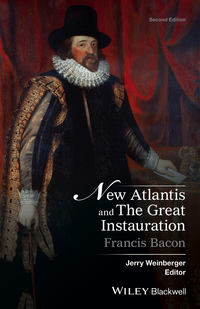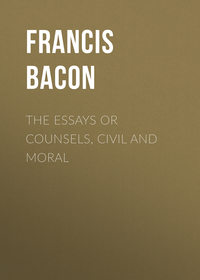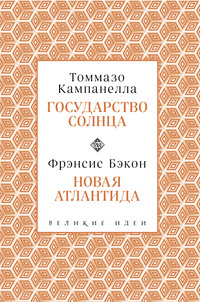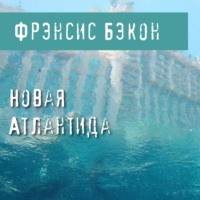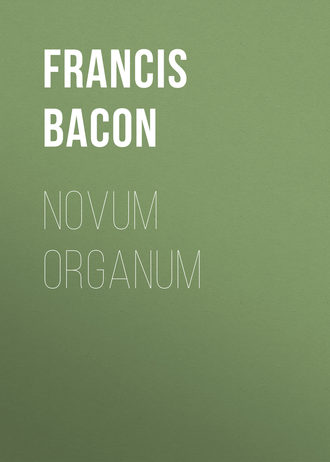 полная версия
полная версияNovum Organum
Laying aside all ambiguity, therefore, we must lastly consider the true differences which limit motion and render it the form of heat.
I. The first difference is, that heat is an expansive motion, by which the body strives to dilate itself, and to occupy a greater space than before. This difference is principally seen in flame, where the smoke or thick vapor is clearly dilated and bursts into flame.
It is also shown in all boiling liquids, which swell, rise, and boil up to the sight, and the process of expansion is urged forward till they are converted into a much more extended and dilated body than the liquid itself, such as steam, smoke, or air.
It is also shown in wood and combustibles where exudation sometimes takes place, and evaporation always.
It is also shown in the melting of metals, which, being very compact, do not easily swell and dilate, but yet their spirit, when dilated and desirous of further expansion, forces and urges its thicker parts into dissolution, and if the heat be pushed still further, reduces a considerable part of them into a volatile state.
It is also shown in iron or stones, which though not melted or dissolved, are however softened. The same circumstance takes place in sticks of wood, which become flexible when a little heated in warm ashes.
It is most readily observed in air, which instantly and manifestly expands with a small degree of heat, as in Inst. 38, Tab. 3.
It is also shown in the contrary nature of cold; for cold contracts and narrows every substance;105 so that in intense frosts nails fall out of the wall and brass cracks, and heated glass exposed suddenly to the cold cracks and breaks. So the air, by a slight degree of cold, contracts itself, as in Inst. 38, Tab. 3. More will be said of this in the inquiry into cold.
Nor is it to be wondered at if cold and heat exhibit many common effects (for which see Inst. 32, Tab. 2), since two differences, of which we shall presently speak, belong to each nature: although in the present difference the effects be diametrically opposed to each other. For heat occasions an expansive and dilating motion, but cold a contracting and condensing motion.
II. The second difference is a modification of the preceding, namely, that heat is an expansive motion, tending toward the exterior, but at the same time bearing the body upward. For there is no doubt that there be many compound motions, as an arrow or dart, for instance, has both a rotatory and progressive motion. In the same way the motion of heat is both expansive and tending upward.
This difference is shown by putting the tongs or poker into the fire. If placed perpendicularly with the hand above, they soon burn it, but much less speedily if the hand hold them sloping or from below.
It is also conspicuous in distillations per descensum, which men are wont to employ with delicate flowers, whose scent easily evaporates. Their industry has devised placing the fire above instead of below, that it may scorch less; for not only flame but all heat has an upward tendency.
Let an experiment be made on the contrary nature of cold, whether its contraction be downward, as the expansion of heat is upward. Take, therefore, two iron rods or two glass tubes, alike in other respects, and warm them a little, and place a sponge, dipped in cold water, or some snow, below the one and above the other. We are of opinion that the extremities will grow cold in that rod first where it is placed beneath, as the contrary takes place with regard to heat.
III. The third difference is this; that heat is not a uniform expansive motion of the whole, but of the small particles of the body; and this motion being at the same time restrained, repulsed, and reflected, becomes alternating, perpetually hurrying, striving, struggling, and irritated by the repercussion, which is the source of the violence of flame and heat.
But this difference is chiefly shown in flame and boiling liquids, which always hurry, swell, and subside again in detached parts.
It is also shown in bodies of such hard texture as not to swell or dilate in bulk, such as red-hot iron, in which the heat is most violent.
It is also shown by the fires burning most briskly in the coldest weather.
It is also shown by this, that when the air is dilated in the thermometer uniformly and equably, without any impediment or repulsion, the heat is not perceptible. In confined draughts also, although they break out very violently, no remarkable heat is perceived, because the motion affects the whole, without any alternating motion in the particles; for which reason try whether flame do not burn more at the sides than in its centre.
It is also shown in this, that all burning proceeds by the minute pores of bodies – undermining, penetrating, piercing, and pricking them as if with an infinite number of needle-points. Hence all strong acids (if adapted to the body on which they act) exhibit the effects of fire, from their corroding and pungent nature.
The difference of which we now speak is common also to the nature of cold, in which the contracting motion is restrained by the resistance of expansion, as in heat the expansive motion is restrained by the resistance of contraction.
Whether, therefore, the particles of matter penetrate inward or outward, the reasoning is the same, though the power be very different, because we have nothing on earth which is intensely cold.
IV. The fourth difference is a modification of the preceding, namely, that this stimulating or penetrating motion should be rapid and never sluggish, and should take place not in the very minutest particles, but rather in those of some tolerable dimensions.
It is shown by comparing the effects of fire with those of time. Time dries, consumes, undermines, and reduces to ashes as well as fire, and perhaps to a much finer degree; but as its motion is very slow, and attacks very minute particles, no heat is perceived.
It is also shown in a comparison of the dissolution of iron and gold; for gold is dissolved without the excitement of any heat, but iron with a vehement excitement of it, although most in the same time, because in the former the penetration of the separating acid is mild, and gently insinuates itself, and the particles of gold yield easily, but the penetration of iron is violent, and attended with some struggle, and its particles are more obstinate.
It is partially shown, also, in some gangrenes and mortifications of flesh, which do not excite great heat or pain, from the gentle nature of the putrefaction.
Let this suffice for a first vintage, or the commencement of the interpretation of the form of heat by the liberty of the understanding.
From this first vintage the form or true definition of heat (considered relatively to the universe and not to the sense) is briefly thus – Heat is an expansive motion restrained, and striving to exert itself in the smaller particles.106 The expansion is modified by its tendency to rise, though expanding toward the exterior; and the effort is modified by its not being sluggish, but active and somewhat violent.
With regard to the operative definition, the matter is the same. If you are able to excite a dilating or expansive motion in any natural body, and so to repress that motion and force it on itself as not to allow the expansion to proceed equally, but only to be partially exerted and partially repressed, you will beyond all doubt produce heat, without any consideration as to whether the body be of earth (or elementary, as they term it), or imbued with celestial influence, luminous or opaque, rare or dense, locally expanded or contained within the bounds of its first dimensions, verging to dissolution or remaining fixed, animal, vegetable, or mineral, water, or oil, or air, or any other substance whatever susceptible of such motion. Sensible heat is the same, but considered relatively to the senses. Let us now proceed to further helps.
XXI. After our tables of first review, our rejection or exclusive table, and the first vintage derived from them, we must advance to the remaining helps of the understanding with regard to the interpretation of nature, and a true and perfect induction, in offering which we will take the examples of cold and heat where tables are necessary, but where fewer instances are required we will go through a variety of others, so as neither to confound investigation nor to narrow our doctrine.
In the first place, therefore, we will treat of prerogative instances;107 2. Of the supports of induction; 3. Of the correction of induction; 4. Of varying the investigation according to the nature of the subject; 5. Of the prerogative natures with respect to investigation, or of what should be the first or last objects of our research; 6. Of the limits of investigation, or a synopsis of all natures that exist in the universe; 7. Of the application to practical purposes, or of what relates to man; 8. Of the preparations for investigation; 9. And lastly, of the ascending and descending scale of axioms.108
XXII. Among the prerogative instances we will first mention solitary instances. Solitary instances are those which exhibit the required nature in subjects that have nothing in common with any other subject than the nature in question, or which do not exhibit the required nature in subjects resembling others in every respect except that of the nature in question; for these instances manifestly remove prolixity, and accelerate and confirm exclusion, so that a few of them are of as much avail as many.
For instance, let the inquiry be the nature of color. Prisms, crystalline gems, which yield colors not only internally but on the wall, dews, etc., are solitary instances; for they have nothing in common with the fixed colors in flowers and colored gems, metals, woods, etc., except the color itself. Hence we easily deduce that color is nothing but a modification of the image of the incident and absorbed light, occasioned in the former case by the different degrees of incidence, in the latter by the various textures and forms of bodies.109 These are solitary instances as regards similitude.
Again, in the same inquiry the distinct veins of white and black in marble, and the variegated colors of flowers of the same species, are solitary instances; for the black and white of marble, and the spots of white and purple in the flowers of the stock, agree in every respect but that of color. Thence we easily deduce that color has not much to do with the intrinsic natures of any body, but depends only on the coarser and as it were mechanical arrangement of the parts. These are solitary instances as regards difference. We call them both solitary or wild, to borrow a word from the astronomers.
XXIII. In the second rank of prerogative instances we will consider migrating instances. In these the required nature passes toward generation, having no previous existence, or toward corruption, having first existed. In each of these divisions, therefore, the instances are always twofold, or rather it is one instance, first in motion or on its passage, and then brought to the opposite conclusion. These instances not only hasten and confirm exclusion, but also reduce affirmation, or the form itself, to a narrow compass; for the form must be something conferred by this migration, or, on the contrary, removed and destroyed by it; and although all exclusion advances affirmation, yet this takes place more directly in the same than in different subjects; but if the form (as it is quite clear from what has been advanced) exhibit itself in one subject, it leads to all. The more simple the migration is, the more valuable is the instance. These migrating instances are, moreover, very useful in practice, for since they manifest the form, coupled with that which causes or destroys it, they point out the right practice in some subjects, and thence there is an easy transition to those with which they are most allied. There is, however, a degree of danger which demands caution, namely, lest they should refer the form too much to its efficient cause, and imbue, or at least tinge, the understanding with a false notion of the form from the appearance of such cause, which is never more than a vehicle or conveyance of the form. This may easily be remedied by a proper application of exclusion.
Let us then give an example of a migrating instance. Let whiteness be the required nature. An instance which passes toward generation is glass in its entire and in its powdered state, or water in its natural state, and when agitated to froth; for glass when entire, and water in its natural state, are transparent and not white, but powdered glass and the froth of water are white and not transparent. We must inquire, therefore, what has happened to the glass or water in the course of this migration; for it is manifest that the form of whiteness is conveyed and introduced by the bruising of the glass and the agitation of the water; but nothing is found to have been introduced but a diminishing of the parts of the glass and water and the insertion of air. Yet this is no slight progress toward discovering the form of whiteness, namely, that two bodies, in themselves more or less transparent (as air and water, or air and glass), when brought into contact in minute portions, exhibit whiteness from the unequal refraction of the rays of light.
But here we must also give an example of the danger and caution of which we spoke; for instance, it will readily occur to an understanding perverted by efficients, that air is always necessary for producing the form of whiteness, or that whiteness is only generated by transparent bodies, which suppositions are both false, and proved to be so by many exclusions; nay, it will rather appear (without any particular regard to air or the like), that all bodies which are even in such of their parts as affect the sight exhibit transparency, those which are uneven and of simple texture whiteness, those which are uneven and of compound but regular texture all the other colors except black, but those which are uneven and of a compound irregular and confused texture exhibit blackness. An example has been given, therefore, of an instance migrating toward generation in the required nature of whiteness. An instance migrating toward corruption in the same nature is that of dissolving froth or snow, for they lose their whiteness and assume the transparency of water in its pure state without air.
Nor should we by any means omit to state, that under migrating instances we must comprehend not only those which pass toward generation and destruction, but also those which pass toward increase or decrease, for they, too, assist in the discovery of the form, as is clear from our definition of a form and the Table of Degrees. Hence paper, which is white when dry, is less white when moistened (from the exclusion of air and admission of water), and tends more to transparency. The reason is the same as in the above instances.110
XXIV. In the third rank of prerogative instances we will class conspicuous instances, of which we spoke in our first vintage of the form of heat, and which we are also wont to call coruscations, or free and predominant instances. They are such as show the required nature in its bare substantial shape, and at its height or greatest degree of power, emancipated and free from all impediments, or at least overcoming, suppressing, and restraining them by the strength of its qualities; for since every body is susceptible of many united forms of natures in the concrete, the consequence is that they mutually deaden, depress, break, and confine each other, and the individual forms are obscured. But there are some subjects in which the required nature exists in its full vigor rather than in others, either from the absence of any impediment, or the predominance of its quality. Such instances are eminently conspicuous. But even in these care must be taken, and the hastiness of the understanding checked, for whatever makes a show of the form, and forces it forward, is to be suspected, and recourse must be had to severe and diligent exclusion.
For example, let heat be the required nature. The thermometer is a conspicuous instance of the expansive motion, which (as has been observed) constitutes the chief part of the form of heat; for although flame clearly exhibits expansion, yet from its being extinguished every moment, it does not exhibit the progress of expansion. Boiling water again, from its rapid conversion into vapor, does not so well exhibit the expansion of water in its own shape, while red-hot iron and the like are so far from showing this progress, that, on the contrary, the expansion itself is scarcely evident to the senses, on account of its spirit being repressed and weakened by the compact and coarse particles which subdue and restrain it. But the thermometer strikingly exhibits the expansion of the air as being evident and progressive, durable and not transitory.111
Take another example. Let the required nature be weight. Quicksilver is a conspicuous instance of weight; for it is far heavier than any other substance except gold, which is not much heavier, and it is a better instance than gold for the purpose of indicating the form of weight; for gold is solid and consistent, which qualities must be referred to density, but quicksilver is liquid and teeming with spirit, yet much heavier than the diamond and other substances considered to be most solid; whence it is shown that the form of gravity or weight predominates only in the quantity of matter, and not in the close fitting of it.112
XXV. In the fourth rank of prerogative instances we will class clandestine instances, which we are also wont to call twilight instances; they are as it were opposed to the conspicuous instances, for they show the required nature in its lowest state of efficacy, and as it were its cradle and first rudiments, making an effort and a sort of first attempt, but concealed and subdued by a contrary nature. Such instances are, however, of great importance in discovering forms, for as the conspicuous tend easily to differences, so do the clandestine best lead to genera, that is, to those common natures of which the required natures are only the limits.
As an example, let consistency, or that which confines itself, be the required nature, the opposite of which is a liquid or flowing state. The clandestine instances are such as exhibit some weak and low degree of consistency in fluids, as a water bubble, which is a sort of consistent and bounded pellicle formed out of the substance of the water. So eaves’ droppings, if there be enough water to follow them, draw themselves out into a thin thread, not to break the continuity of the water, but if there be not enough to follow, the water forms itself into a round drop, which is the best form to prevent a breach of continuity; and at the moment the thread ceases, and the water begins to fall in drops, the thread of water recoils upward to avoid such a breach. Nay, in metals, which when melted are liquid but more tenacious, the melted drops often recoil and are suspended. There is something similar in the instance of the child’s looking-glass, which little boys will sometimes form of spittle between rushes, and where the same pellicle of water is observable; and still more in that other amusement of children, when they take some water rendered a little more tenacious by soap, and inflate it with a pipe, forming the water into a sort of castle of bubbles, which assumes such consistency, by the interposition of the air, as to admit of being thrown some little distance without bursting. The best example is that of froth and snow, which assume such consistency as almost to admit of being cut, although composed of air and water, both liquids. All these circumstances clearly show that the terms liquid and consistent are merely vulgar notions adapted to the sense, and that in reality all bodies have a tendency to avoid a breach of continuity, faint and weak in bodies composed of homogeneous parts (as is the case with liquids), but more vivid and powerful in those composed of heterogeneous parts, because the approach of heterogeneous matter binds bodies together, while the insinuation of homogeneous matter loosens and relaxes them.
Again, to take another example, let the required nature be attraction or the cohesion of bodies. The most remarkable conspicuous instance with regard to its form is the magnet. The contrary nature to attraction is non-attraction, though in a similar substance. Thus iron does not attract iron, lead lead, wood wood, nor water water. But the clandestine instance is that of the magnet armed with iron, or rather that of iron in the magnet so armed. For its nature is such that the magnet when armed does not attract iron more powerfully at any given distance than when unarmed; but if the iron be brought in contact with the armed magnet, the latter will sustain a much greater weight than the simple magnet, from the resemblance of substance in the two portions of iron, a quality altogether clandestine and hidden in the iron until the magnet was introduced. It is manifest, therefore, that the form of cohesion is something which is vivid and robust in the magnet, and hidden and weak in the iron. It is to be observed, also, that small wooden arrows without an iron point, when discharged from large mortars, penetrate further into wooden substances (such as the ribs of ships or the like), than the same arrows pointed with iron,113 owing to the similarity of substance, though this quality was previously latent in the wood. Again, although in the mass air does not appear to attract air, nor water water, yet when one bubble is brought near another, they are both more readily dissolved, from the tendency to contact of the water with the water, and the air with the air.114 These clandestine instances (which are, as has been observed, of the most important service) are principally to be observed in small portions of bodies, for the larger masses observe more universal and general forms, as will be mentioned in its proper place.115
XXVI. In the fifth rank of prerogative instances we will class constitutive instances, which we are wont also to call collective instances. They constitute a species or lesser form, as it were, of the required nature. For since the real forms (which are always convertible with the given nature) lie at some depth, and are not easily discovered, the necessity of the case and the infirmity of the human understanding require that the particular forms, which collect certain groups of instances (but by no means all) into some common notion, should not be neglected, but most diligently observed. For whatever unites nature, even imperfectly, opens the way to the discovery of the form. The instances, therefore, which are serviceable in this respect are of no mean power, but endowed with some degree of prerogative.
Here, nevertheless, great care must be taken that, after the discovery of several of these particular forms, and the establishing of certain partitions or divisions of the required nature derived from them, the human understanding do not at once rest satisfied, without preparing for the investigation of the great or leading form, and taking it for granted that nature is compound and divided from its very root, despise and reject any further union as a point of superfluous refinement, and tending to mere abstraction.
For instance, let the required nature be memory, or that which excites and assists memory. The constitutive instances are order or distribution, which manifestly assists memory: topics or commonplaces in artificial memory, which may be either places in their literal sense, as a gate, a corner, a window, and the like, or familiar persons and marks, or anything else (provided it be arranged in a determinate order), as animals, plants, and words, letters, characters, historical persons, and the like, of which, however, some are more convenient than others. All these commonplaces materially assist memory, and raise it far above its natural strength. Verse, too, is recollected and learned more easily than prose. From this group of three instances – order, the commonplaces of artificial memory, and verses – is constituted one species of aid for the memory,116 which may be well termed a separation from infinity. For when a man strives to recollect or recall anything to memory, without a preconceived notion or perception of the object of his search, he inquires about, and labors, and turns from point to point, as if involved in infinity. But if he have any preconceived notion, this infinity is separated off, and the range of his memory is brought within closer limits. In the three instances given above, the preconceived notion is clear and determined. In the first, it must be something that agrees with order; in the second, an image which has some relation or agreement with the fixed commonplaces; in the third, words which fall into a verse: and thus infinity is divided off. Other instances will offer another species, namely, that whatever brings the intellect into contact with something that strikes the sense (the principal point of artificial memory), assists the memory. Others again offer another species, namely, whatever excites an impression by any powerful passion, as fear, shame, wonder, delight, assists the memory. Other instances will afford another species: thus those impressions remain most fixed in the memory which are taken from the mind when clear and least occupied by preceding or succeeding notions, such as the things we learn in childhood, or imagine before sleep, and the first time of any circumstance happening. Other instances afford the following species: namely, that a multitude of circumstances or handles assist the memory, such as writing in paragraphs, reading aloud, or recitation. Lastly, other instances afford still another species: thus the things we anticipate, and which rouse our attention, are more easily remembered than transient events; as if you read any work twenty times over, you will not learn it by heart so readily as if you were to read it but ten times, trying each time to repeat it, and when your memory fails you looking into the book. There are, therefore, six lesser forms, as it were, of things which assist the memory: namely – 1, the separation of infinity; 2, the connection of the mind with the senses; 3, the impression in strong passion; 4, the impression on the mind when pure; 5, the multitude of handles; 6, anticipation.


